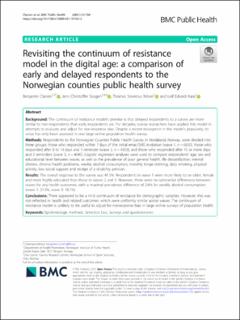| dc.contributor.author | Clarsen, Benjamin Matthew | |
| dc.contributor.author | Skogen, Jens Christoffer | |
| dc.contributor.author | Nilsen, Thomas Sevenius | |
| dc.contributor.author | Aarø, Leif Edvard | |
| dc.date.accessioned | 2021-09-20T11:30:15Z | |
| dc.date.available | 2021-09-20T11:30:15Z | |
| dc.date.created | 2021-05-06T13:43:18Z | |
| dc.date.issued | 2021 | |
| dc.identifier.citation | BMC Public Health. 2021, 21(1), Artikkel 730. | en_US |
| dc.identifier.issn | 1471-2458 | |
| dc.identifier.uri | https://hdl.handle.net/11250/2779187 | |
| dc.description | This article is licensed under a Creative Commons Attribution 4.0 International License, which permits use, sharing, adaptation, distribution and reproduction in any medium or format, as long as you give appropriate credit to the original author(s) and the source, provide a link to the Creative Commons licence, and indicate if changes were made. The images or other third party material in this article are included in the article's Creative Commons licence, unless indicated otherwise in a credit line to the material. If material is not included in the article's Creative Commons licence and your intended use is not permitted by statutory regulation or exceeds the permitted use, you will need to obtain permission directly from the copyright holder. To view a copy of this licence, visit http://creativecommons.org/licenses/by/4.0/. The Creative Commons Public Domain Dedication waiver (http://creativecommons.org/publicdomai/zero/1.0/) applies to the data made available in this article, unless otherwise stated in a credit line to the data. | en_US |
| dc.description.abstract | Background: The continuum of resistance model’s premise is that delayed respondents to a survey are more similar to non-respondents than early respondents are. For decades, survey researchers have applied this model in attempts to evaluate and adjust for non-response bias. Despite a recent resurgence in the model’s popularity, its value has only been assessed in one large online population health survey.
Methods: Respondents to the Norwegian Counties Public Health Survey in Hordaland, Norway, were divided into three groups: those who responded within 7 days of the initial email/SMS invitation (wave 1, n = 6950); those who responded after 8 to 14 days and 1 reminder (wave 2, n = 4950); and those who responded after 15 or more days and 2 reminders (wave 3, n = 4045). Logistic regression analyses were used to compare respondents’ age, sex and educational level between waves, as well as the prevalence of poor general health, life dissatisfaction, mental distress, chronic health problems, weekly alcohol consumption, monthly binge drinking, daily smoking, physical activity, low social support and receipt of a disability pension.
Results: The overall response to the survey was 41.5%. Respondents in wave 1 were more likely to be older, female and more highly educated than those in waves 2 and 3. However, there were no substantial differences between waves for any health outcomes, with a maximal prevalence difference of 2.6% for weekly alcohol consumption (wave 1: 21.3%, wave 3: 18.7%).
Conclusions: There appeared to be a mild continuum of resistance for demographic variables. However, this was not reflected in health and related outcomes, which were uniformly similar across waves. The continuum of resistance model is unlikely to be useful to adjust for nonresponse bias in large online surveys of population health. | en_US |
| dc.language.iso | eng | en_US |
| dc.subject | epidemiologic methods | en_US |
| dc.subject | selection bias | en_US |
| dc.subject | surveys and questionnaires | en_US |
| dc.title | Revisiting the continuum of resistance model in the digital age: A comparison of early and delayed respondents to the Norwegian counties public health survey | en_US |
| dc.type | Peer reviewed | en_US |
| dc.type | Journal article | en_US |
| dc.description.version | publishedVersion | en_US |
| dc.rights.holder | © The Author(s). 2021 | en_US |
| dc.source.pagenumber | 10 | en_US |
| dc.source.volume | 21 | en_US |
| dc.source.journal | BMC Public Health | en_US |
| dc.source.issue | 1 | en_US |
| dc.identifier.doi | 10.1186/s12889-021-10764-2 | |
| dc.identifier.cristin | 1908533 | |
| dc.description.localcode | Institutt for idrettsmedisinske fag / Department of Sports Medicine | en_US |
| dc.source.articlenumber | 730 | en_US |
| cristin.ispublished | true | |
| cristin.fulltext | original | |
| cristin.qualitycode | 1 | |
